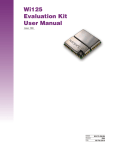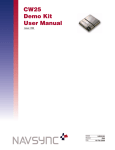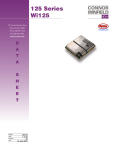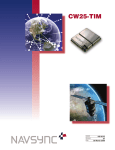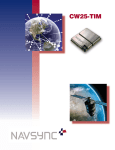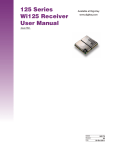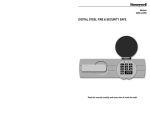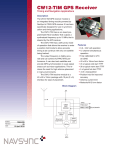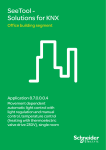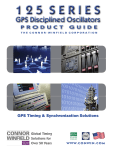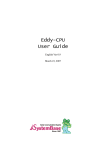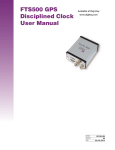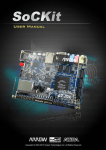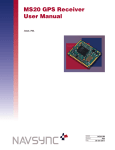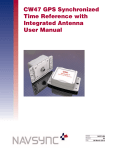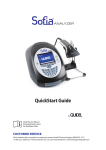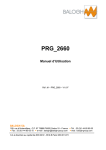Download Wi125 Evaluation Kit User Manual - Connor
Transcript
Wi125 Evaluation Kit User Manual Available at Digi-Key www.digikey.com Issue: R01 Bulletin Revision Date SG172-DKUM R01 06 May 2010 Table of Contents 1. Introduction 3 2. Wi125 Evaluation Board Overview 3 3. General Specifications 4 3.1 Operating Specifications 4 4. Interfaces 5 4.1 Power 5 4.2 Wi125 (U3) 5 4.3 UART Connections (J1, J2, J3) 5 4.4 Antenna Connection (J8) 5 4.5 Power On and Reset Switches 5 4.6 LED Indicators 5 4.7 Timing Outputs 6 5. Operating Instructions 6 6. Connector Pin outs 7 6.1 Jumper Description & Settings 7 6.2 RS232 DB9 Connectors 7 6.3 DC Power Connector 7 6.4 SMA Timing and Event-In Connectors 7 6.5 TNC Antenna Connector 7 6.6 External Clock Connector 8 6.7 Auxiliary Connector 8 6.8 JTAG Connector 8 Appendix 1 Evaluation Board Schematic SG172 Wi125 Evaluation Kit User Manual 9 Page 2 Rev: 01 Date: 05/06/10 © Copyright 2010 The Connor-Winfield Corp. All Rights Reserved Specifications subject to change without notice 1. Introduction The Wi125 Evaluation Kit is a complete development platform for the Wi125 GPS receiver (Wi125). It is comprised of the Wi125 Evaluation Board and peripherals that support its operation. The Wi125 is a small size OEM module specifically designed for use in weak signal GPS environments and where there is a requirement for highly accurate timing. Refer to Wi125 User Manual for details. The Full Wi125 Evaluation Kit includes: • • • • Wi125 Evaluation Board Interface DB9 Serial RS232 Cable Power Supply Adaptor (Region Specific) with 2.1 mm plug. Magnetic Patch Antenna with a 3m lead The Wi125 Evaluation Board can be purchased individually with a pick-and-choose option for accessories. This may reduce cost if the customer already possesses such accessories. 2. Wi125 Evaluation Board Overview The main purpose of the Wi125 Evaluation Board is to provide a power supply, battery backup, RS232 interface and easy access to the Wi125 functionality. A TNC connector is available for an active antenna and SMA connectors are on board for easy connection to the 1PPS and frequency timing outputs. Access to the Event-In pin is also available through an SMA connection. The antenna power is provided by on-board circuitry. A connection point (BT1) is available as an alternate to the 2.1 Barrel Socket for a DC power supply. If field tests need to be carried out, a 4AA battery pack can also be attached to the BT1 connection port. The Wi125 Evaluation Board is a stand-alone GPS board, providing simple interfaces to host systems such as a PC. The Evaluation Board provides: • • • • • • • • • On-board Wi125 3.3VDC Power Regulation, which allowing input voltage of 4.5VDC to 25VDC RS232 Interface to each of the 3 UARTs of the Wi125: NMEA, Debug, Net Assist RF-IN Female TNC connector SMA CO-AX connector for the 1PPS and Frequency outputs Battery Backup Circuit for the Wi125’s RTC when power is not applied. LED Indicators for GPS status, Power status and a 1PPS blinking LED Current measuring headers at the Wi125 power supply inputs Reset and Power switches Event In (J7) Frequency Out (J6) 1 PPS (J5) DC Power (BT1) DC Power (J4) Power Switch (S1) Antenna Power Jumper (J4) UART1 (J1) Wi125 Reset Switch (SW1) UART2 (J2) Timing Outputs Antenna Connector (J8) UART3 (J3) LEDs Figure 1 Wi125 Evaluation Board SG172 Wi125 Evaluation Kit User Manual © Copyright 2010 The Connor-Winfield Corp. Page 3 Rev: 01 Date: 05/06/10 All Rights Reserved Specifications subject to change without notice 3. General Specifications If not otherwise specified, all performance data refers to the Wi125. 3.1 Operating Specifications Parameter Min Operating Temperature -30 Power Supply Voltage (VDC) 4.5 Power Consumption Typical Max Units +65 °C 25 VCC 5 0.62 UART Interfaces (x3) J1, J2, J3 D-SUB 9-WAY, RS232 Active Antenna Connector TNC Socket Female W Power Connector (DC)2.1mm Barrel, Center Positive [Cliff DC-10] Dimensions 125 x 120 x 30mm (approx, Board Only) Weight 128g (approx, Board Only) Wi125 GPS Receiver Figure 2 Wi125 Evaluation Board Block Diagram SG172 Wi125 Evaluation Kit User Manual Page 4 Rev: 01 Date: 05/06/10 © Copyright 2010 The Connor-Winfield Corp. All Rights Reserved Specifications subject to change without notice 4. Interfaces 4.1Power The Wi125 Evaluation Board can be operated from two sources of DC power: a standard DC Power adaptor with a 2.1mm DC Plug connected to J4, or the alternative connection point BT1, a battery pack or DC cables which can be soldered directly to the ± terminals. 4.2Wi125 (U3) The Wi125 is soldered on the board. Please see the Wi125 data sheet along with the Wi125 User Manual for detailed information. 4.3UART Connections (J1, J2, J3) The Wi125 Evaluation Board provides RS232 level shifting (TX, RX, GND) to interface the Wi125 GPS receiver with a PC via either a standard serial port or a USB-serial adapter (example Roline USB Type A -serial DB9ST). For detailed information of data streams and command format refer to User Manual. UART 1 (J1) - Main UART of the Wi125, for NMEA message and Command Configurations UART 2 (J2) - Debug Messages UART 3 (J3) - Net Assist 4.4Antenna Connection (J8) The antenna is connected using the female socket TNC connector, J8, on the Wi125 Evaluation Board. A patch antenna is supplied with the kit. If the necessary antenna has a different connector, a suitable adaptor is required. The Evaluation Board provides 3.3VDC at the antenna jack to power active antennas. Higher voltage antenna can be accommodated (up to +15VDC) by routing the input power Vin to power the antenna. Jumper header JP4 determines the source power for the antenna. The jumper is placed in the‘P2’ position for direct DC-IN or P1 for the standard 3.3VDC on-board supply. If the ‘P2’ position is used the board supply input voltage must remain below 15VDC. Care must be taken to insure that no more than 50mA is drawn from the Antenna connection otherwise damage may be caused to the Wi125 unit. 4.5Power On and Reset Switches The Power-On Slide Switch, S1, enables the 3.3VDC Regulator. When power is connected to the board and S1 is in the ‘ON’ position, the yellow LED, D1 will be on continuously. The Reset Push switch, SW1, is connected to the NPOR signal of the Wi125 unit. This can be pushed to reset the Wi125. 4.6LED Indicators Power-ON LED, D1 This yellow LED is fully on when 3.3VDC is applied to the Board. 1PPS LED, D2 This 1PPS LED toggles ON/OFF when the 1PPS signal is present. GPS Status Red, D3 On the standard Wi125 software builds, the GPS Red works as follows: - Long red flash for invalid GPS fix - Short red flashes for satellites tracked, but not used in solution. GPS Status Green, D4 On the standard Wi125 software builds, the GPS Green works as follows; - Long green flash for a valid 2D/3D fix - Short green flashes for number of satellites used in solution SG172 Wi125 Evaluation Kit User Manual © Copyright 2010 The Connor-Winfield Corp. Page 5 Rev: 01 Date: 05/06/10 All Rights Reserved Specifications subject to change without notice 4. Indicators continued 4.7Timing Outputs 1PPS Output SMA, J5 - female standard socket. The 1PPS signal from the Wi125 is available here. It is directly connected to Pin 38 through a 33 ohm resistor. A buffered 1PPS is also available on Pin 1 of each of the DB9 connectors. This signal can be inverted by selecting the ‘P2’ position of jumper header, JP5. Otherwise the Jumper is placed on ‘P1’ for the standard non-inverting buffered 1PPS. Please note that these buffered 1PPS signals are CMOS levels, not RS232 levels. Frequency Output SMA, J6 - female standard socket. The default frequency from the Wi125 is 10Mhz. The SMA conductor is directly connected to Pin 39 through a 33 ohm resistor. Event –In Input SMA, J7 - female standard socket. Connected to the Event-In (Pin 39) of the Wi125. This is connected through a 33 ohm resistor. 5. Operating Instructions 1. Connect the Antenna to the TNC socket, J8 2. Place the Patch antenna in a sky view location 3. Connect a RS232 data cable (also an available accessory) to the NMEA Port, J3 4. Connect the remaining end of the cable to the RS232 COM port on a PC 5. Open Terminal Window or NavSync NS3K View GPS parser on the PC, with communications setting set to match the COM port used and the baud rate set to 38400 (default) 6. Connect the Power supply to the Board 7. Place the Slide Switch, S1, to position 1 to switch Power ON 8. The unit should start to stream data 9. Once the unit achieves a GPS lock, timing outputs will be valid and present SG172 Wi125 Evaluation Kit User Manual Page 6 Rev: 01 Date: 05/06/10 © Copyright 2010 The Connor-Winfield Corp. All Rights Reserved Specifications subject to change without notice 6. Connector Pin outs 6.1Jumper Description & Settings JUMPER DESCRITPION Normal Position JP1 DIG Power to Wi125, 3.3VDC ON JP2 RF Power to Wi125, 3.3VDC ON JP3 DIG Power to Wi125, 1.8VDC ON JP4 Antenna Supply, P1: 3.3VDCP2: Powered directly from J4/BT1 P1 JP5 Buffered 1PPS to J1/J2/J3(Pin1) SelectionP1: 1PPS+(NON-INV)P2: 1PPS-(INV) P1 JP6 Bootsel, Only to be placed when programming OFF JP7 Freq out to Event-in ON JP8 VBAT POWER TO Wi125 ON 6.2RS232 DB9 Connectors J1 - NMEA and Command J2- Debug J3 - Net Assist Pins Description Pins Description Pins Description 1 1PPS+/1PPS- Buffered 1 1PPS+/1PPS- Buffered 1 1PPS+/1PPS- Buffered 2 TX0 RS232 Levels 2 TX1 RS232 Levels 2 TX2 RS232 Levels 3 RX0 RS232 Levels 3 RX1 RS232 Levels 3 RX2 RS232 Levels 5 GND 5 GND 5 GND 6.3DC Power Connector The DC power connector is a 2.1mm Barrel center positive socket connector [Cliff Component: DC-10A] J4- DC -IN Pins Description CENTER DC Power in + (4.5-25v) OUTER DC Power in - (GND) 6.4SMA Timing and Event-In Connectors J5 1PPS J6 Frequency Out Connected directly to Pin 38 of the Wi125 via a 33ohm resistor Connected directly to Pin 39 of the Wi125 via a 33ohm resistor J7 Event In Connected directly to Pin 37 of the Wi125 via a 33ohm resistor 6.5TNC Antenna Connector This TNC is a standard TNC socket. J8 RF-IN A GPS TNC active antenna can be connected here. Power is supplied to the antenna from the Evaluation Board, see JP4 description. SG172 Wi125 Evaluation Kit User Manual © Copyright 2010 The Connor-Winfield Corp. Page 7 Rev: 01 Date: 05/06/10 All Rights Reserved Specifications subject to change without notice 6. Connector Pin outs continued 6.6External Clock Connector J9- Not fitted on Evaluation Board, only used for special hardware builds of the Wi125 6.7Auxiliary Connector The pins on this non-fitted connector are directly connected to the Wi125 J10 Auxiliary Connections Pins Description 1 GPIO1(PIN 40) 2 Pins Description 9 TX1(PIN 5) GND 10 RX1(PIN 6) 3 GPIO2(PIN 41) 11 TX2(PIN 3) 4 GND 12 RX2(PIN 4) 5 GPIO3(PIN 42) 13 N2WDA(PIN 29) 6 GND 14 N2WCK(PIN 28) 7 TX0(PIN 1) 15 USBP(PIN 30) 8 RX0(PIN 2) 16 USBN(PIN 31) 6.8JTAG Connector The pins on this non-fitted connector are directly connected to the Wi125 J11 JTAG Connections Pins Description Pins Description 1 VCC 3.3VDC 11 JSEL (PIN 21) 2 VCC 3.3VDC 12 GND 3 NTRST (PIN 15) 13 TDO (PIN 13) 4 GND 14 GND 5 TDI (PIN 14) 15 NRESET (PIN 10) 6 GND 16 GND 7 TMS (PIN 22) 17 NC 8 GND 18 GND 9 TCK (TDI) 19 NC 10 GND 20 GND SG172 Wi125 Evaluation Kit User Manual Page 8 Rev: 01 Date: 05/06/10 © Copyright 2010 The Connor-Winfield Corp. All Rights Reserved Specifications subject to change without notice Appendix 1 Evaluation Board Schematic SG172 Wi125 Evaluation Kit User Manual © Copyright 2010 The Connor-Winfield Corp. Page 9 Rev: 01 Date: 05/06/10 All Rights Reserved Specifications subject to change without notice Wi125 Evaluation Kit User Manual Available at Digi-Key www.digikey.com Issue: R01 Revision Revision Date Notes P00 02/03/09 Release R00 02/16/09 Public Release R01 05/06/10 Updates to Schematics & Drawings NavSync, Ltd. Europe Bay 143 Shannon Industrial Estate Shannon, Co. Clare, Ireland Phone: +353 61 475 666 E-mail: [email protected] North America 2111 Comprehensive Drive Aurora, IL 60505, USA Phone: 630.236.3026 E-mail: [email protected] www.navsync.com










